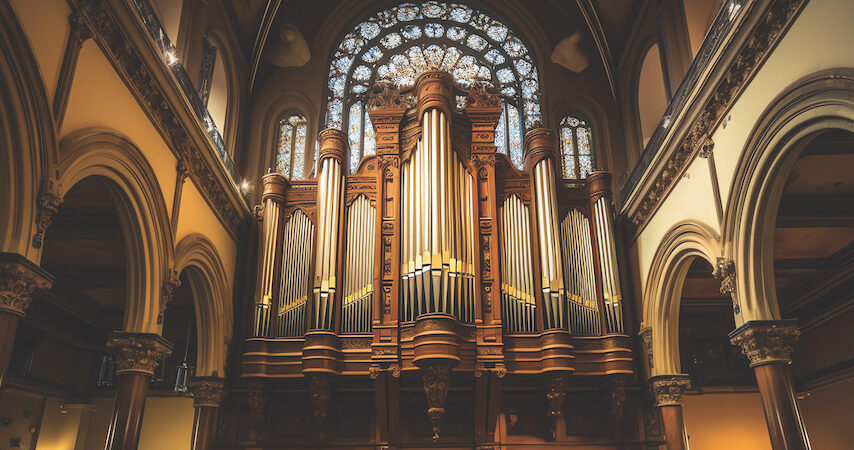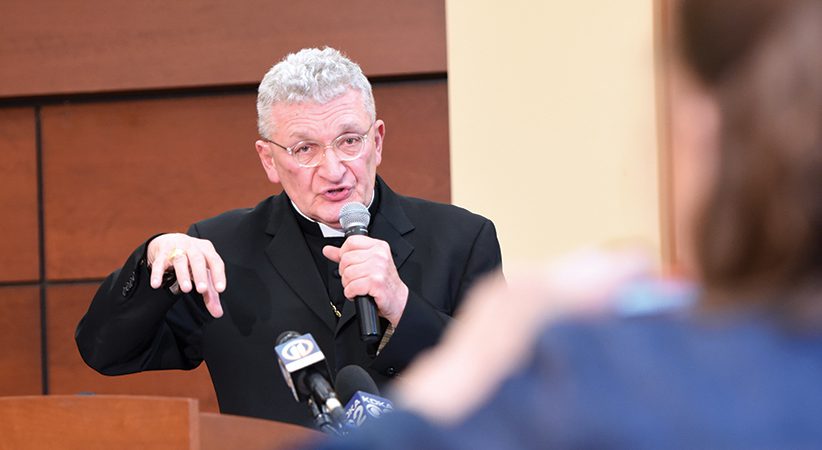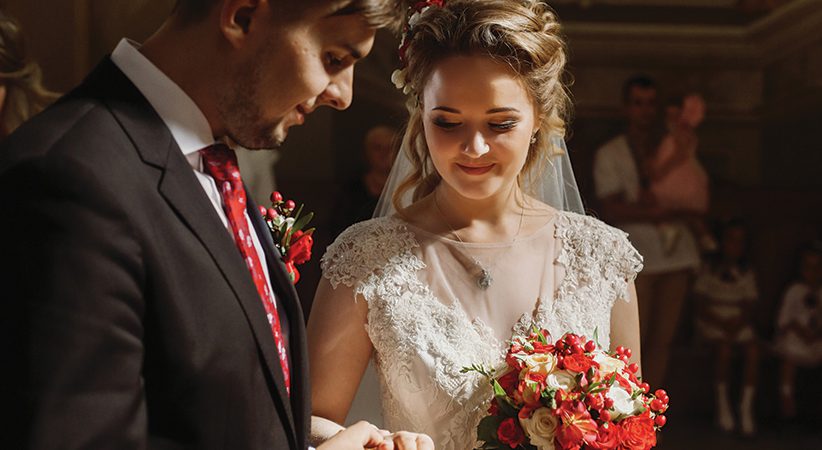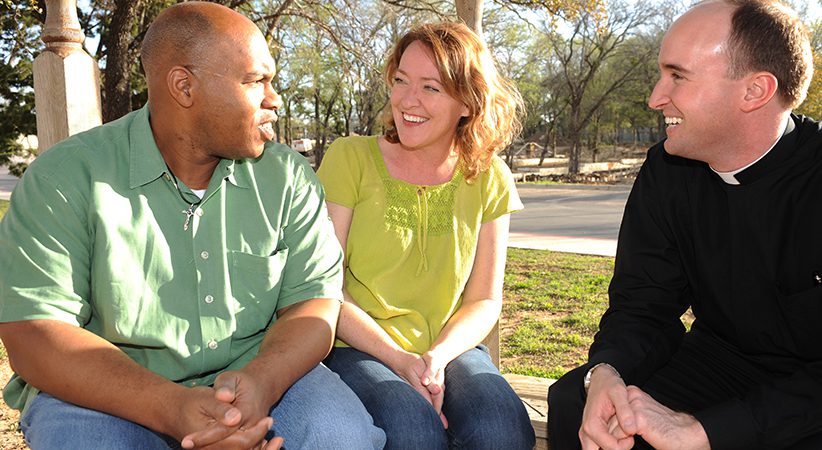When Mere Speech Is Not Enough
Reflections on sacred music in the parish of today’s Church
Chaz Bowers Comments Off on When Mere Speech Is Not Enough
In my time spent teaching college courses in sacred music, I am often challenged with the question, “Where should I begin when improving music at my future parish?” — as though there might be a one-size-fits-all method to improving music in the Western Church. The ensuing conversation can quickly become a charged one because music can become a source of division. The good news, however, is that when experiencing true beauty, especially in music, we can find a source of togetherness and oneness.
I enjoy answering the question, because the Church, in her two millennia of wisdom, gives us the answers we need. From the various musical suggestions supplied in the Roman Missal itself to the liturgical norms for music found in the General Instruction of the Roman Missal and other various documents on sacred music, to the proper and ordinary texts prescribed for use in the Mass, alongside many other valid and beautiful options, musicians have so much opportunity to foster true and authentic beautiful Catholic liturgical music.
So, here are a few ideas I offer.
Advocate the Sung Mass
The recent death of Pope Benedict XVI reminded me of my favorite quote from his “The Spirit of the Liturgy” (Ignatius Press, $19.95), written before he became pontiff: “When man comes into contact with God, mere speech is not enough.” I believe that this quote could, in due time, become as noted as St. Augustine’s famous oration “he who sings, prays twice.”
Both of these quotes enlighten us about the importance of the sung Mass. Benedict explains areas of man’s existence “are awakened that spontaneously turn into song.” Singing was and is, even today, the highest form of praise to God. This is true throughout all history, not just the history of the Christian Church. Consider the song of the Israelites in Exodus 15:1 who passed across the red sea, “I will sing to the LORD, for he is gloriously triumphant; / horse and chariot he has cast into the sea.” African American spirituals are another example.
With that in mind, my advice to these students is to work with their parish priests to develop a plan to begin to sing the Mass. Not to simply sing at Mass, but to sing the Mass. The General Instruction of the Roman Missal tells us, “In the choosing of the parts actually to be sung, preference is to be given to those that are of greater importance and especially to those which are to be sung by the priest or the deacon or a reader, with the people replying, or by the priest and people together” (No. 40). It also says, “It is most appropriate that the Priest sing those parts of the Eucharistic Prayer for which musical notation is provided” (No. 147). Musicam Sacram (the Second Vatican Council’s instruction on music in the liturgy) confirms this, and even goes so far as to prioritize — in three parts — the parts of the Mass that should be sung.
Teaching the assembly to chant the various responses, even in simple tones, is very effective from a musical standpoint for several reasons. First, Catholics generally respond best to their clergy! There is a sort of obligation (or “Catholic guilt,” as we often refer to it in western Pennsylvania) to at least try to sing back! Second, people already know the responses. They’ve been reciting these prayers for over a decade since the most recent changes to the Roman Missal. If they don’t remember them, chanting them can help them because it places the text within a simple melody. Besides that, chanting these texts gives new life and meaning to them and, most importantly, a greater solemnity.
Nearly 10 years ago, when I began in my current post at St. Bernard Church in Pittsburgh, now part of St. Michael the Archangel Parish, I was impressed that the parish priests and assembly could chant the entire Mass — beginning to end — even the somewhat more elaborate chant response “Lord, I am not worthy that you should enter under my roof, but only say the words and my soul shall be healed.” It is possible! And it is important to note that many resources are available for training clergy and parishioners to chant the Mass. The National Pastoral Musicians (NPM) provides free online recordings of all the sung chants of the Mass for practice purposes.
Where to begin? “Start simply with one dialogue,” I advise. It is possible to begin to chant these things recto tono (reciting tone) or with a simple descending third cadence. Simple chant can sometimes be the most effective and the most beautiful because it can involve everyone — at least until everyone has gotten their feet wet. Volumes of keyboard accompaniments have been written for most chants to give some tonality to the more difficult ones. I have heard sung Masses with other traditional, contemporary and even ethnic music performed — it is a way that we can all be one.
Foster Beauty in Sacred Music
We all experience beauty in different ways, and everyone seems to have personal preferences regarding exactly what music and texts should be sung, and whether it should be accompanied, and by what. Of this, Pope Pius X said it best, “[Sacred music] must possess proper liturgical qualities, primarily holiness and goodness of form; from which its other note, universality, is derived.” He regarded Gregorian chant as the supreme model for all sacred music and sacred music composition.
Regardless of the genre of music, it is important to recognize that there is no substitute for beauty. In fact, I have found one thing to hold true throughout my career: No one likes to join a choir that sounds bad. So I advise students, whatever they are singing, make sure that their music is performed with beauty and dignity befitting the holy Mass. It is important to recognize the strengths and abilities of singers — both cantors and choristers — and to build from there. I personally love Gregorian chant and polyphony, but I also recognize that there is perhaps nothing worse than that genre of music being sung poorly. The same holds true for contemporary and folk music in the Church. Sometimes, simple music sung extremely well is better than complex music that does not foster beauty.
In a February 2022 interview, Pope Francis said, “An authentic artist is able to speak about God better than anyone else, to make people perceive his beauty and goodness, to ‘reach the human heart and make the truth and goodness of the risen Lord shine in it.’”
It is also crucial to recognize that beauty is expressed in different ways. One of my favorite quotes from Pope St. John Paul II is in his ad limina address to the bishops of the United States on Oct. 9, 1998, on active participation in the liturgy. In it, he reveals to us that we can also participate through listening:
“Active participation does not preclude the active passivity of silence, stillness and listening: indeed, it demands it. Worshippers are not passive, for instance, when listening to the readings or the homily, or following the prayers of the celebrant, and the chants and music of the liturgy. These are experiences of silence and stillness, but they are in their own way profoundly active. In a culture which neither favors nor fosters meditative quiet, the art of interior listening is learned only with difficulty. Here we see how the liturgy, though it must always be properly inculturated, must also be countercultural.”
Just as we are inspired by the beautiful art and architecture of a building, even though we did not participate in its creation, we can be inspired by the beauty of music through active listening.
Understand the Role of Music and Musicians in the Liturgy
As a musician, I can say firsthand that it is easy to want to put our own personal preferences into the liturgy. This is not necessary, though, because, as Catholic musicians, the Church gives us clear guidance on exactly what we are to do. I spend a lot of time showing students how to find out what it is that the Church asks of us and our work. As is the case in many aspects of liturgical planning, there are often options. This allows room for creativity and gives each parish the ability to select music that will foster beautiful worship for their community.
It is, therefore, essential that Church musicians be familiar with the rubrics (Latin: ruber, for red) set forth in the Roman Missal, the General Instruction of the Roman Missal and Musicam Sacram, at a minimum. These sources provide a clear understanding of what the universal Church offers in the way of music in the liturgy. Priests will resound with the phrase “say the black, do the red,” and it is important to foster that mentality among musicians. Once a musician understands the rubrics, they can, in collaboration with their parish pastor and priest, employ the various options. There is still room for creativity in the confines of what is given to us by the Church.
Educate and Communicate
A friend of mine, who is a concertgoer and organ enthusiast, often says that “Church musicians are the worst when it comes to self-promotion.” Alas, he is right — perhaps because of the humble nature that comes with being a church musician. However, even though musicians don’t often talk about their plans and intentions, it is important that the faithful, the clergy and the singers under their leadership are all on the same page. There are certainly people out there that like liturgical trivia or, if nothing else, simply like to understand what is going on. By educating people — most of the time, this can be as simple as a few lines in a bulletin article or worship aid, or even a verbal announcement — we give them the chance to understand on a deeper level. In the words of Pope St. John Paul II at the October 1998 ad limina visit with U.S. bishops: “Conscious participation calls for the entire community to be properly instructed in the mysteries of the liturgy, lest the experience of worship degenerate into a form of ritualism.”
Be Catholic!
I lastly advise my students to be authentically Catholic in the music they select. (I likewise advise students serving in other denominations to be true to the particular church that they serve.) What I mean by this is, first, to choose music from one’s own tradition if a good option is available. Second, I advise them to be sure that the music employed in the liturgy is in accord with all the Church teaches. In my opinion, some commonly used Communion hymns, especially those borrowed from other denominations, can fall into a sort of gray area here. In fact, in September 2020, the United States Conference of Catholic Bishops penned a document entitled “Catholic Hymnody at the Service of the Church: An Aid for Evaluating Hymn Lyrics.” This document provided some much-needed clarification for the use of hymns during the Mass.
Throughout this conversation with students, I like to remind them that we live in a good time to be Church musicians. Despite the difficulties and struggles present in both the world and the Church, armed with the guidance the Church gives us in sacred music we are well-equipped for the hard work ahead! In the aforementioned audience with a group of artists in 2022, Pope Francis confirms the importance of a musician’s role: “In the difficult current context that the world is experiencing, in which sadness and distress sometimes seem to have the upper hand, your mission is more necessary than ever, because beauty is always a source of joy, putting us in touch with divine goodness.”
CHAZ BOWERS is the director of music at St. Michael the Archangel Parish, Pittsburgh, Pennsylvania, and adjunct professor of organ and sacred music at Franciscan University in Steubenville, Ohio. He is a published composer of church music and a past dean of the Pittsburgh chapter of the American Guild of Organists.
……………………………………………………………………………………………………………………………………………….
Some General Music Norms
“Whenever, for a liturgical service which is to be celebrated in sung form, one can make a choice between various people, it is desirable that those who are known to be more proficient in singing be given preference; this is especially the case in more solemn liturgical celebrations and in those which either require more difficult singing, or are transmitted by radio or television.
“If, however, a choice of this kind cannot be made, and the priest or minister does not possess a voice suitable for the proper execution of the singing, he can render without singing one or more of the more difficult parts which concern him, reciting them in a loud and distinct voice. However, this must not be done merely for the convenience of the priest or minister.
“In selecting the kind of sacred music to be used, whether it be for the choir or for the people, the capacities of those who are to sing the music must be taken into account. No kind of sacred music is prohibited from liturgical actions by the Church as long as it corresponds to the spirit of the liturgical celebration itself and the nature of its individual parts, and does not hinder the active participation of the people.
“In order that the faithful may actively participate more willingly and with greater benefit, it is fitting that the format of the celebration and the degree of participation in it should be varied as much as possible, according to the solemnity of the day and the nature of the congregation present.” — Musicam Sacram, Nos. 8-10
………………………………………………………………………………………………………………………………………………..





